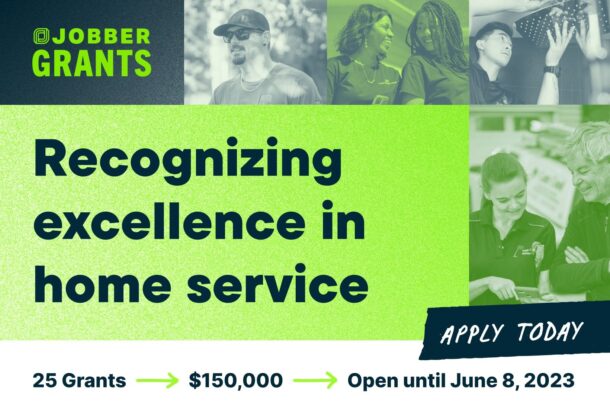Home Service businesses to benefit from focus on maintenance projects as homeowners regain financial flexibility Jobber, the leading provider of home service software, today released its latest Home Service Economic Report: 2024 Q3. The report features expert insights and proprietary data aggregated from more than 250,000 residential cleaners, landscapers, HVAC technicians, electricians, plumbers, and more, who Read more
Jobber

Home Service businesses to benefit from focus on maintenance projects as homeowners regain financial flexibility
Jobber, the leading provider of home service software, today released its latest Home Service Economic Report: 2024 Q3. The report features expert insights and proprietary data aggregated from more than 250,000 residential cleaners, landscapers, HVAC technicians, electricians, plumbers, and more, who run their businesses using Jobber.
The U.S. Federal Reserve’s recent interest rate cuts are already showing early signs of impact on consumer spending, bringing cautious optimism for the home service industry. After a slower first half of 2024, Jobber’s data shows increased momentum through the end of Q3, signaling a gradual recovery fueled by improved financial flexibility for consumers. These findings are also supported by the Michigan Consumer Sentiment Index (MCSI), a monthly survey based on interviews that measure U.S. consumer attitudes towards personal finances, business conditions and economic activity.

“As we move through the second half of 2024, we’re seeing encouraging signs for the home service category—especially as financial conditions continue to improve and consumer confidence grows,” said Sam Pillar, CEO & co-founder of Jobber. “At Jobber, we’re committed to helping small home service businesses capitalize on these opportunities, and the data we’re seeing suggests a path toward sustained growth in the months and years ahead.”
Demand for Home Service Outpaces Consumer Goods
Despite fluctuations in new work volume, consumer demand for home services held steady in Q3, with spending on services outpacing consumer goods. Higher average invoice sizes helped stabilize revenue, balancing the variability in new work. As interest rate cuts improve disposable income and consumer sentiment, household spending power is expected to rise, potentially driving further growth in home service demand.
Economists anticipate that the interest rate cuts will continue into 2025, providing greater affordability in areas like mortgage rates and financing for home improvements. This environment is expected to boost activity across both the housing and home service markets as consumers look to invest in essential home maintenance and renovation projects.
The housing market remains closely tied to demand for home services, and recent data indicates a promising future for this sector. While certain indicators, such as construction spending, new permits, and housing starts, have shown temporary stagnation, the cumulative effect of rate cuts is projected to revitalize the market by mid-2025. Rising home equity and expected increases in home improvements will drive demand for both discretionary and essential projects, pushing projected annual spending to $477 billion by Q3 2025, nearing previous peak levels.
Jobber’s report includes insights on the four key segments within the home services category, revealing trends in consumer spending and business resilience:
- Green: The Green segment, which includes lawn care and landscaping, saw early growth in 2024, though activity slowed in Q3 except for July. Despite economic pressures, median revenue remained stable as homeowners prioritized smaller, recurring outdoor maintenance over large renovations.
- Cleaning: Cleaning services, including residential and commercial cleaning, have seen rising median prices but declining volumes in 2024. While new work scheduled fluctuated due to reduced consumer spending, service providers have maintained stable revenue growth by increasing prices and focusing on premium offerings.
- Contracting: The Contracting segment, covering services like electricians and HVAC, experienced a downturn in new work scheduled by late Q3. Nonetheless, median revenue stayed steady, likely due to pricing adjustments and a shift toward higher-value projects.
- Construction: Construction services, including residential and commercial projects, have seen an improvement in median revenue as consumer spending shifts toward maintenance and improvements. However, new work scheduled continued to decline in Q3, reflecting cautious spending amid the gradual economic recovery.
“The 2024 Q3 Jobber Home Service Economic Report shows a promising outlook for the home services sector as interest rate cuts start to boost consumer spending and demand,” said Abheek Dhawan, Senior VP, Strategy & Analytics at Jobber. “With rising home equity and a shift toward maintenance projects, we anticipate steady growth as financial conditions improve. The sector is well-positioned to benefit from an aging housing stock and increased focus on essential updates, setting the stage for sustained demand and expansion through 2025 and beyond.”
To download the Jobber Home Service Economic Report: 2024 Q3, visit: https://getjobber.com/home-service-reports/nov-2024/

Even as concern around white-collar jobs grows due to AI and economic uncertainties, Jobber’s report reveals hesitancy among Gen Zs to pursue trades careers Jobber, the leading provider of home service software, today released The Annual Blue-Collar Report: Gen Z and the Trades Need Each Other. The report, based on survey responses from 1,000 students in the Read more
Even as concern around white-collar jobs grows due to AI and economic uncertainties, Jobber’s report reveals hesitancy among Gen Zs to pursue trades careers

Jobber, the leading provider of home service software, today released The Annual Blue-Collar Report: Gen Z and the Trades Need Each Other. The report, based on survey responses from 1,000 students in the U.S. aged 18-20, provides insight into how Gen Z navigates education and career choices, as well as offers solutions on how to inspire and encourage younger generations to consider taking advantage of all that blue-collar careers have to offer.
According to The Annual Blue-Collar Report, 76% of Gen Zs agree there is a stigma associated with going to vocational school over a traditional four-year university. This reality threatens our homes, economy, and the livelihoods of younger generations.
“If you own a home, you have a problem,” warns Sam Pillar, CEO and co-founder of Jobber. “While there is some renewed interest among the younger generation to pursue blue-collar careers, there’s still far too much work homeowners need done, and not enough workers to do it. We need to do a better job showing Gen Z how incredible the opportunities in the trades are, and encouraging them to consider that path.”
The U.S. housing stock is aging rapidly, with the median age of homes reaching 40 years. This is a critical problem as the U.S. is experiencing a labor shortage across most industries as labor force participation declines and the workforce ages and retires. In addition, the U.S. Bureau of Labor Statistics states that employment demands in trade industries are often greater than or pacing the 3% average of all occupations, representing not just a gap, but a growing chasm.
Key findings from the report provide deeper insights into why Gen Z is not pursuing blue-collar careers and how society can encourage younger generations to consider them. Despite the growing stigma and misconceptions that Gen Z has, The Annual Blue-Collar Report clearly shows that they actually do want blue-collar careers, and just don’t know it yet.
The “American Dream” needs a blue-collar rebrand
Gen Z has been taught to measure success through a white-collar lens, but AI, the economy, and layoffs are changing their minds. Their concerns around white-collar careers are clear.
- One-third (33%) of Gen Z say that white-collar desk jobs are less stable today than they were for their parents’ generation.
- 41% of Gen Z agree that the potential for AI to replace jobs has made it harder to achieve the “American Dream” and 46% believe there will be fewer future job opportunities as a result.
- 70% of Gen Z say they are not optimistic about the future of the economy.
- When asked what would make a trade career more appealing, Gen Z described what blue-collar professions already offer, including flexible work hours (73%), job stability (61%), and overtime pay (58%).
Gen Z’s biggest career influences are letting them down
Parents have blue-collar blindness, schools deserve a failing grade for blue-collar education, and Hollywood is doing hard work dirty.
- Family (51%) was identified as the biggest influence on Gen Z and the careers they chose to pursue by a significant margin.
- 61% of Gen Z say their parents haven’t spoken to them about vocational school or told them not to consider it.
- Just 17% of Gen Z say they have been educated on the benefits of vocational training following high school graduation. This was significantly lower than bachelor’s degree, community college, military service, and entrepreneurship.
- More than a third (35%) of Gen Z say television shows and movies have influenced the careers they want to explore and 47% describe trade professionals as being generally portrayed negatively (incompetent, unhealthy, and/or unhappy) in shows and movies.
We simply need more women in the trades
While many workforces have evolved to accommodate the modern gender distribution of labor, the trades have yet to establish this balance.
- Nearly half (48%) of Gen Z agree that women are discouraged from pursuing trade careers from a young age.
- 58% of Gen Z say that women face more discrimination within trade careers—compared to other career options—with the majority of women (68%) believing this compared to men (47%).
In addition to survey data and insights, The Annual Blue-Collar Report offers testimonials from people like 27-year-old commercial and residential electrician, Lexis Czumak-Abreu, who attests to the benefits of blue-collar work: “I studied pre-med in school, intending to become a surgeon but decided to become an electrician instead. Many people in my family are electricians, including my dad. The salary is great, the hours are stable, and the work is very gratifying!”
Finally, The Annual Blue-Collar Report highlights 10 specific calls to action for the general public, blue-collar professionals, policymakers and educators, and the media to help connect the dots between Gen Z’s fears and desires and the blue-collar opportunity in front of them, as well as eliminate the existing harmful stereotypes.
To access The Annual Blue-Collar Report Powered by Jobber, visit jobber.com/blue-collar.

New integration marks CallRail’s commitment to expanding investment across the home services category CallRail, the AI-powered lead intelligence platform, today announced an integration with Jobber, the leading provider of operations management software for home service businesses. With this integration, mutual customers—such as landscapers, plumbers, HVAC technicians, and painters—will get a better understanding of the performance of Read more
New integration marks CallRail’s commitment to expanding investment across the home services category
CallRail, the AI-powered lead intelligence platform, today announced an integration with Jobber, the leading provider of operations management software for home service businesses. With this integration, mutual customers—such as landscapers, plumbers, HVAC technicians, and painters—will get a better understanding of the performance of their acquisition channels and gain deeper insights into those leads to win more business without having to leave the Jobber platform.

By connecting to the CallRail app in the Jobber app marketplace, service pros will be able to see how potential leads discovered their business, the connection between the marketing sources and keywords that led to booked jobs, and view the communications history each lead had with their business.
“Teaming up with Jobber continues our longstanding commitment to supporting home service professionals as the only lead intelligence software directly integrated into technology that services pros are already using everyday,” Marc Ginsberg, CallRail CEO, said. “Our technology automatically surfaces actionable insights from calls and highlights the marketing activities that are bringing those leads. Now, these insights are available within the Jobber platform and connected with job-specific data to help service pros know what’s bringing their most profitable jobs.”
While the home service category continues to see a steady demand for services, advertising costs have increased significantly, causing many businesses to rely on lower cost lead generation services. The partnership will specifically enable mutual customers to easily access unprecedented details about customer journey, from lead to job, as well as unparalleled access to customer conversation data through CallRail’s Conversation Intelligence® platform. This will be especially important in 2024 as service pros will need to consider alternative ways to grow revenue and save on costs according to the latest Jobber Home Service Economic Report.
“Spending money on marketing can be intimidating for home service businesses, which often operate on tight budgets where every dollar counts,” said Sam Pillar, CEO and co-founder of Jobber. “These entrepreneurs want assurance that their hard-earned dollars are being invested efficiently. At Jobber, we want to take the guesswork out of running a successful home service business and provide the right tools for service pros to win work faster. This integration with CallRail is a great example of how we are doing that.”
“Marketing is critical to the success of our home services business, but wasting money on ads that don’t bring in leads can be detrimental,” said Branden Sewell, Owner of Seal Pro Painting. “Knowing where leads are coming from helps me know which marketing strategies are working effectively, and which ones need to be adjusted or scrapped. It saves time, money, and allows our business to focus on what matters most: booking jobs and getting paid.”
To learn more about how home service pros can make the most of this partnership, visit: https://callrail.com/blog/jobber-integration-easier-lead-management

New tool makes it easier to balance pricing, labor costs, and expenses to fully understand every job’s profit margin Jobber, the leading provider of operations management software for home service businesses, today announced the launch of a new job costing feature that enables home service businesses in any industry, including contracting and construction, landscaping, tree Read more
New tool makes it easier to balance pricing, labor costs, and expenses to fully understand every job’s profit margin
Jobber, the leading provider of operations management software for home service businesses, today announced the launch of a new job costing feature that enables home service businesses in any industry, including contracting and construction, landscaping, tree care, painting, HVAC, and roofing, to more accurately track and understand job costs and profit margins. The feature delivers increased insight into the labor, material, and miscellaneous expenses associated with a job to better understand its profitability, and to ensure service pros are earning the highest profit margins possible—without the complexity of switching between spreadsheets and multiple software.
“With material and labor costs rising, and pricing pressure increasing from homeowners, it’s easy for small businesses to get into situations where jobs become unprofitable,” said Sam Pillar, CEO & co-founder of Jobber. “One of the key measures of success for our customers is profitability. Unknowingly taking a loss on a job due to incorrect costing can have a negative impact on a business. Jobber’s new job costing feature simplifies the tracking of input costs and profitability so service pros can make important operational decisions, stay competitive, and take on the work that’s ultimately going to grow their businesses.”
The feature helps ensure that one-off jobs, such as plumbing repairs, handiwork, and landscaping projects, are profitable by tracking costs and calculating profit margins in real-time directly on the job page. Service pros can also view these trends in a report to compare profitability for different jobs and get insights to improve future pricing, estimation, and resource allocation. The profitability of each job is calculated using:
- Timesheets: Based on the hourly cost of each employee and their time worked on a job.
- Line items: The materials used on the job, including both the unit cost and price.
- Expenses: These are the expenses spent on a job
“Jobber has done a great job streamlining and organizing my business, and now with the new job costing feature, it has taken our efficiency to the next level,” said Scott Geddis, owner of M&M Skylights based in Newton, New Hampshire. “We’ve increased our revenue by 15 to 20% because I’m able to look at the data and determine in real-time what jobs were most profitable, allowing me to price future jobs with more accuracy. The tool is simple to use and helps to ensure we’re running a profitable business so we can continue growing and rewarding our staff for their hard work.”
Job costing joins a suite of other Jobber tools and integrations that help service pros win more work and generate more revenue. The company’s integration with Thumbtack, for example, helps service pros instantly connect with new customers and book more profitable jobs faster, while the advanced quoting feature gives service pros the ability to sell more with optional line items.
Job costing is available to Jobber customers on the Grow membership plan. To learn more, visit: https://getjobber.com/features/job-costing-software/.

First-of-its-kind grant program has helped launch, grow, and strengthen 55 home service businesses to date Jobber, the leading provider of operations management software for home service businesses, today announced that Jobber Grants, designed to recognize home service excellence and spotlight the work of small home service businesses across the U.S. and Canada, is now accepting Read more
First-of-its-kind grant program has helped launch, grow, and strengthen 55 home service businesses to date
Jobber, the leading provider of operations management software for home service businesses, today announced that Jobber Grants, designed to recognize home service excellence and spotlight the work of small home service businesses across the U.S. and Canada, is now accepting applications through June 8, 2023. Twenty-five businesses will be awarded grants totaling $150,000 USD. Finalists will be announced in August 2023. Apply at jobber.com/grants.

Home service professionals, ranging from aspiring to experienced business owners, are invited to apply for grants ranging from $2,500 to $15,000 USD. The five-minute application is designed for busy home service pros in any industry, including lawn care, plumbing, residential cleaning, and painting.
“Investing in home service businesses means giving back to our communities, facilitating job creation, and boosting local economies,” said Sam Pillar, CEO & co-founder of Jobber. “We’re proud to continue Jobber’s tradition of investing in local entrepreneurs at all stages of growth to help them achieve their goals and ambitions.”
Alex Neville-Verdugo, owner of Lefty’s Handy Services and former Jobber Grants recipient, is using the funds to grow her business. With the grant, she invested in training for her team that allowed her to expand her services to include home renovation projects. In addition to the capital, the exposure from being named a recipient resulted in new customers, which has accelerated the growth of her business during her slow season.
“Even before the money kicked in, Jobber Grants was a game changer for me,” said Neville-Verdugo. “My local newspaper wrote a piece about us, the entire community read it, and now I get stopped on the streets. I have gotten a huge amount of business from that article and have been sprinting ever since it came out—that alone was a game changer.”
Jobber Grants are organized into several categories that reflect the diverse representation of excellence across home service, which looks different from business to business. Categories include:
- Home Service Heroes: Business owners who keep our home and offices safe and running smoothly.
- Career Builders: Business owners who help hardworking people build meaningful careers.
- Smooth Operators: Business owners running a smooth business for themselves and their customers.
- Community Caretakers: Business owners who give back to the communities where they live and work.
Recipients have the freedom to choose how to use the grant to support their ambitious business goals and innovative ideas. Whether a company is looking to purchase new equipment, increase its marketing investment, launch a new service, or train their teams, funds from the Jobber Grants program are designed to help small business owners be more successful.
Ethan Rossler, owner of Wash Wizard and a Jobber Grant recipient, dreamed of starting a business shortly after graduating college. The grant provided the initial investment needed to launch his pressure washing business.
“Being a Jobber Grants recipient has allowed me to take advantage of my goals of starting a business,” said Rossler. “The funds have given me the opportunity to buy the startup materials necessary to actually start the business that I’ve always wanted to start.”
Jobber Grants is one of the many initiatives launched by Jobber dedicated to supporting and elevating home service entrepreneurs, including the company’s award-winning business operations software, events such as Jobber Summit, free resources to help launch, grow, and scale a business via Jobber Academy, Salary Guides, Jobber Entrepreneurship Group, trends and insights in the Jobber Home Service Economic Report, and more.
To learn more about Jobber Grants or to apply, visit jobber.com/grants.
